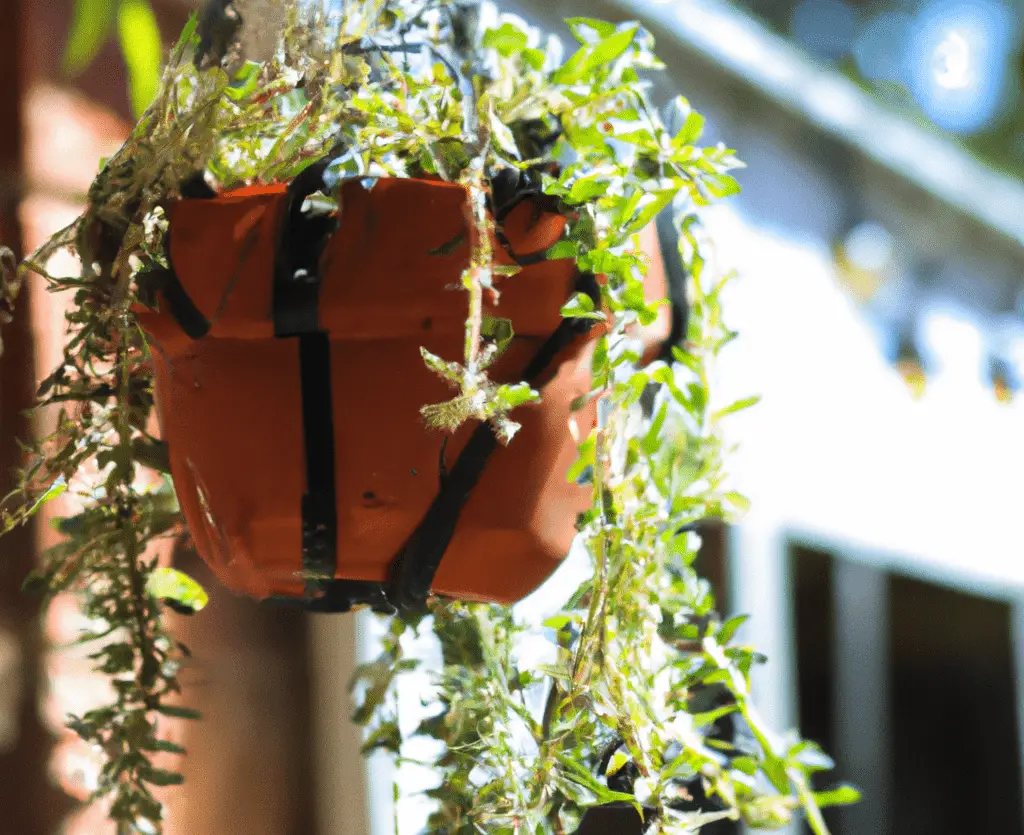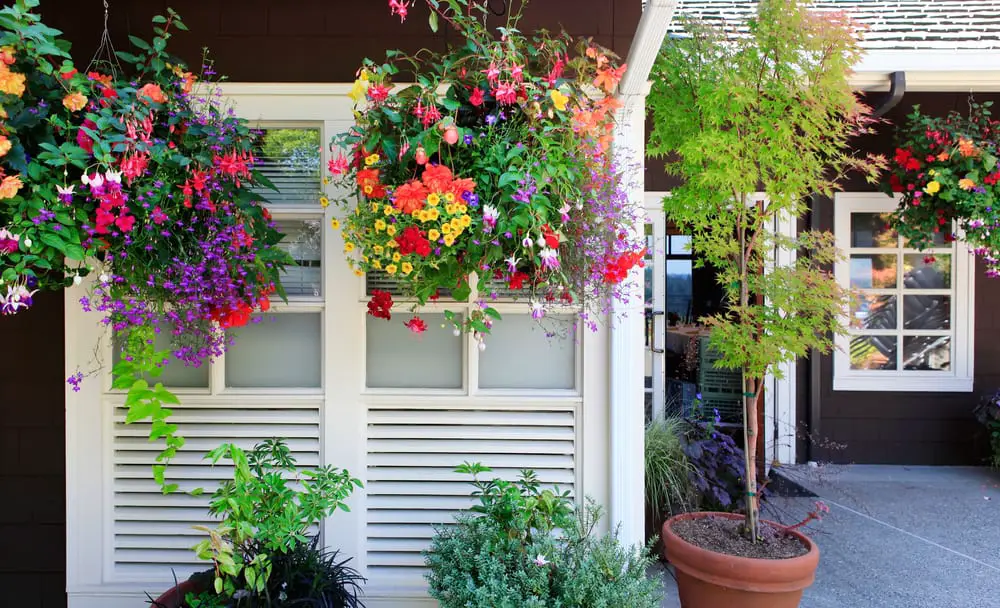Birds come into your yards and gardens for various reasons, and often times it is a pleasure to have these playful and musical animals flitting about. Sometimes problematic birds enter your lawn, and then bird control is needed to eliminate common nuisance birds. In my experience, these bird issues crop up around hanging plants and other basket planters more often than around other areas of the garden.
Once I saw this pattern, I began looking into why planter baskets were causing issues with birds and if there was a certain species of bird that was more likely to want to nest in hanging plants. Dealing with a plant with birds can be stressful, especially if there are baby birds. To learn how to keep birds away from your hanging plants and what to do if they already moved in, read on below.
Do Hanging Plants Attract Birds
Plants hanging from eaves and rafters outdoors, or even from tree branches, fence posts, or other standing structures, do have a tendency to attract birds. There are many reasons why this happens, and some of them depend on the types of birds and existing sites for birds on and around your property.
Birds tend to be opportunistic and need places to sleep, nest, eat, and find fresh water. If your hanging basket plants are the only place to find any of these things, the chances they will attract nuisance birds increase.
It is possible that your hanging plants may only attract birds during a certain season and that your planters are being used as nesting boxes and then abandoned afterward. Keeping an eye on which birds are attracted to your hanging planters, what time of year they show up, and what they do there can help you figure out the best natural bird-repellent methods and effective bird prevention tips.
After all, who wants to constantly clean bird poop off of their plants and patio areas?
Why Are Birds Attracted To Hanging Plants

If you are having an issue with birds and basket planters, then I am sure you would love to know why they are attracted to these locations. What about hanging plants invites pest birds to nest, feed, and then leave messy bird droppings and water and soil messes in their wake?
Below are some of the main reasons parent birds hang out around your basket planters, so you come up with a bird control solution.
| Attractant | Reason | Effect |
| Food and Fragrance | Bugs and nectar attract birds to hanging plant | Birds may damage foliage, disturb the soil, and make messes around the hangers |
| Nests and Security | Hangers are usually in secure areas and offer shade and a safe place to build a nest and care for young out of reach of most predators | Nests can attract pests that harm plants and can make watering and caring for plants difficult |
| Shade and Water | Hanging plants are usually more shade tolerant and will be under eaves or other tall structures, offering relief from the sun and providing unevaporated water to needy birds | Birds will flock to hangers after watering and can make a mess and spill wet soil, attracting other pests to your plant areas |
Food and Fragrance
Hummingbirds and smaller songbirds are often attracted to flowers and plants with nectar and a fragrant aroma. If you have hanging basket planters that produce flora scents and nectar, there is a good chance you will attract birds over time. While these birds are unlikely to choose your planter basket as a nesting spot, their constant comings and goings can create dropping messes and lead to other insect and natural predator activity.
As bugs and potential edible plant components like seeds increase towards the end of the summer, birds may come in large numbers to take advantage of the low-hanging fruit. If birds know there is a good chance they will find a meal, they will visit that spot every day, hoping for a tasty treat. Keep basket planters clean and trimmed to avoid pest infestation and subsequent bird pests.
Nests and Security
Hanging planters are an excellent spot for expectant parent birds to stow away nesting materials. The soil in planters offers a flat surface for bird nests with protection from the elements and larger birds. Growing tomato plants with green tomatoes or ripe tomatoes in basket planters can offer an appealing nesting spot and food that replicates a normal hedge row nesting birds look for when choosing nesting sites.
A plant with birds can quickly become the hangout of other problematic birds that are either predators of the first bird or will use the nest location when the baby birds have moved on. Attractive nesting sites are often used by predator insects and pests that look for a hanging basket with baby birds and egg debris. The protection from predators is the main reason birds choose hanging planter nesting locations over trees and other typical birdhouses.
Shade and Water
Hot, dry summers can be hard for birds that need to constantly search for food, water, and shelter from the scorching sun. Birds may visit a plant for water after you water plants. The water dishes that catch runoff may also frequently be visited for a refreshing drink. Bugs and insects are more likely to come to the surface of the soil when it is soaked and can offer a free buffet for any investigative fowls in the area.
The shade offered by plants growing in the yard can present a place to rest and hide for birds during the summer months. The cool soil and relief the leaves provide will allow a small bird to rest and perhaps grab a bug or two. Where there is shade, there is usually moisture and a bit more water than in the direct sun, so the shaded areas under hanging plants and inside the basket planters can offer hydration when no other fresh sources are available.
How to Keep Pests Away from Hanging Plants?
After you have discovered the likely reasons birds are nesting in your basket planters, you can take the steps to exclude and prevent them from returning year after year. There are bird-repellent sprays, bird spikes, fake predators, reflective objects, and light wire mesh that can all be incorporated to keep your hanging planters bird and nest free. Here are some of the best bird control methods I have used around my home and lawn:
Better Options
I will also advocate for working with nature when possible, as the process of completely excluding creatures from natural living systems is often times expensive and not necessary. If you give birds and other animals better options, they will leave your garden and plants alone.
If you have selectively destroyed all of the food and shelter that birds and other wild animals had access to, then there is a good chance they will be paying your home a garden a visit.
Bird baths or water features, bird feeders full of bird food, and bird nesting boxes placed where you want wild animals can help keep unruly nature away from your meticulous garden and ornamental beds. If you give a small area of your property to free use for beneficial insects and pleasant yard critters, you will have less of an issue in your garden and basket planters. Healthy ecosystems must be maintained, however, or too many pests could enter your lawn and garden and wreak havoc on all you have worked towards.
Barriers
Light wire mesh, chicken wire cages, and bird spikes can be used to preclude birds from entering and nesting in your basket planters. Laying down a light wire mesh prior to planting can also help keep soil and roots inside the planter. Once the plants have begun to grow larger, bird spikes or other barriers can be used to keep birds from landing on or around the planters keeping the whole area clean.
If your basket planter can wire to window sills, it can prevent soil from falling out when they land on or rummage through the hanging plants.
It is important to make sure that no baby birds are living in the nest before applying barriers that would trap baby birds inside and keep parent birds out. It is best to include barriers when you first hang your basket planters, but in case you forget, you may have to wait for the birds to grow up. If there already is a nest, eggs, or baby birds in your hanging planter, check out more info below on what to do about it.
Decoys
A rubber snake can go a long way in keeping birds and other pests out of your hanging plants. While the delight baby birds bring is joyous, keeping parent birds out of planters is easiest with a strong predator decoy. Types of predator decoys vary based on the birds you are trying to scare away, but in most cases, something like an owl or scarecrow is put up to keep birds away.
A fake snake in a basket planter is cheap and easy, and a snake decoy will work longer than other fake predators. Birds expect to find snakes coiled under plants and will not remain long to check if it is real. Snakes also lie still, so a bird will not be able to tell if it is fake as quickly as they would a stationary hawk decoy or another normally active predator.
Deterrents
Keeping birds out of basket planters by making the plants unpleasant for them to be near is also an effective method. Shiny objects hanging from a fishing wire and colorful balls can be used to deter and startle birds. Citrus-soaked cotton balls and a mixture of water can offer an unpleasant aroma to birds while not causing harm to the soil or plants.
A tennis ball hanging from fishing wire or garden balls designed to offend birds can also aid the citrus oil-soaked cotton balls and other natural versions of bird repellent already in the planter. Using a combination of scents and sights can keep birds guessing and reduce the need to install wire and other unsightly fixtures around your basket planters. Citrus-soaked cotton balls will need to be replaced when the scent weakens, or they will become useless and not offer protection any longer.
How to Remove a Bird’s Nest from Hangin Basket Planter?
If a bird has already moved into your planter and you want to get rid of it, there are a few things you can do. I usually watch for the bird coming and going for a few days to determine what kind of bird it is and why it has chosen to nest in my basket planter.
Once I know this information, I check to see the stage of the nest activity. If the nest is mostly complete, I will simply move it, but in some cases, other steps should be taken.
The simplest way to move a nest is to hang another planter similar to the first one next to the original. Move the nest to this planter instead, and then use wire mesh or a barrier to prevent the birds from coming back to the first planter. If the nest has eggs or babies, you can move them but make sure to be very gentle as both eggs and baby birds are extremely fragile.
Make sure to leave the way to the new nest location clear and choose a time when mama bird will not peck you for moving her babies. If you are unable to safely move the nest, then it is advisable to just wait until the birds move on and take action the following year. Once the birds have left the nest in your hanging planter, you can make sure to give them better nesting options to keep birds away from your hanging plants once and for all.



